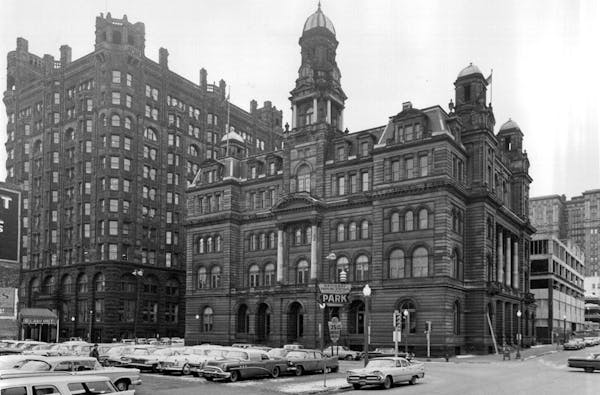One of downtown St. Paul's most intriguing lost buildings is the Grand Arcade (also known as the Lowry Arcade), an elaborate mixed-use structure that once occupied much of the block bounded by Wabasha, St. Peter, 4th and 5th streets.
Completed in 1893, just as the nation plunged into a deep depression, the arcade building didn't garner much attention in the press, and to this day remains little known, even though traces of it still exist.
The building was notable in several respects, beginning with its architect.
It was the last work of E. Townsend Mix, best remembered as the architect of the magnificent Metropolitan Building in downtown Minneapolis, which was razed in the early 1960s. Mix succumbed to tuberculosis in 1890, the same year the Metropolitan Building opened, but just before his death he was commissioned by Thomas Lowry to design the Grand Arcade.
By then, Lowry and Mix knew each other well. Although Lowry made his mark as the father of the Twin Cities streetcar system, he had a hand in many other projects, among them the Northwestern Guaranty Loan Building (renamed the Metropolitan in 1905), which he owned for 10 years.
Mix began work on the Grand Arcade only after an ambitious plan to build an 1,800-seat opera house on the site fell through. Lowry had unveiled the plan with great fanfare in 1889, but shortly after excavations began he abandoned the scheme, for reasons unknown, in favor of the arcade.
By the time he took on the arcade project, Mix had already designed a prominent building for the Daily Globe newspaper in St. Paul. Completed in 1887, the 10-story building (razed in 1959) was at the corner of 4th and Cedar streets, where the Degree of Honor Building now stands.
Only a few glancing photos of the Grand Arcade can be found in local archives. Fortunately, detailed insurance maps published by the Sanborn Co. provide a great deal of information about the building's unusual layout.
As originally constructed, the building included a skylit arcade extending from 4th to 5th streets and the Field, Mahler Department Store, a variety of shops, and large meeting halls for Elks and Masons.
The Elks Club hall occupied the upper floors of the building along 4th. The Masons had an even larger hall on the 5th Street side. Between the halls was a large one-story space occupied by Field, Mahler, which became Field-Schlick in 1896. The department store remained in the same location until it closed in 1979.
As designed by Mix, the Grand Arcade featured three distinctive red brick and brownstone facades, all Romanesque Revival in character. The largest, on 4th, culminated in a stepped-up parapet that reached a height of four stories to screen the Elks hall behind it. The 5th Street facade offered an even more elaborate parapet featuring five rocketlike tourelles. A smaller two-story front along Wabasha served as an entrance to the Field, Mahler store.
Like many Victorian-era buildings in the Twin Cities, the Grand Arcade did not survive long in its original form, in part because both the Elks and Masons moved out by 1910. The Elks relocated to a new hall (long gone) on Washington Street overlooking Rice Park in 1908. Two years later, the Masons built a handsome temple (razed in 1981) a few blocks away on Smith Avenue.
New development adjoining the arcade building also had a significant impact. In 1912 Thomas Lowry's son, Horace, built the 12-story Lowry Medical Arts Building (now apartments) along St. Peter between 4th and 5th. About the same time, the 4th and 5th street sides of the arcade building received Classical Revival face-lifts to blend in with the style of their new neighbor. The building's interior was also remodeled, with office space replacing the old meeting halls.
An even bigger change came in 1932, when the 4th Street portion of the building was demolished to make way for the Lowry Medical Building (now the City Hall Annex). The old Field-Schlick facade on Wabasha also vanished about this time, replaced by a parking garage for the Lowry Hotel, which had opened on the block in 1928.
In 1949 the remaining portion of the arcade building on 5th received yet another redo when new stonework was installed on the ground floor.
Today, nothing is visible of the Grand Arcade as Mix designed. But it's not entirely gone.
When the Lowry Medical Arts Building was converted to apartments in the early 2000s, workers uncovered a portion of one of the arcade's original entrances, still reasonably intact behind the 1949 facade. I have no idea how much more of the old arcade remains, but I suspect some original columns and beams still exist behind all of the remodelings.
In any case, it's nice to know that a little piece of Mix's work still survives against all odds as part of St. Paul's hidden history.
Larry Millett is an architecture critic and author of 14 nonfiction books and eight mystery novels. He can be reached at larrymillett.com.
Live video of man who set himself on fire outside court proves challenging for news organizations
4/20 grew from humble roots to marijuana's high holiday


